Immunization Policies Pre VS Post-Covid
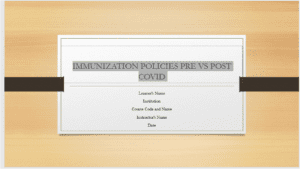
Hello, and welcome to this presentation about immunization policies pre vs post Covid 19. This presentation will cover recommendations of strategies that managers and organizations could use to be more socially responsible in trying to correct the legal and ethical issues in relation to immunization policies.

This is the best strategy that managers and organizations can employ in the effort to address legal and ethical issues following immunization for COVID-19. This is because successful vaccination campaigns have proved to involve partnerships between governments and community organizations to carry out extensive and well-managed community engagement (OECD, 2021). There is a need for a thorough understanding of different community’s specific concerns, political affiliations, religious beliefs, socio-economic status, and prior experiences with the previous immunization and health systems (OECD, 2021). Therefore, it is very crucial that governments or any leader of immunization programs maintain open public scrutiny, public institutional engagement, and localization agenda. This is, of course, the valuing of social science in the effort to address legal and ethical issues associated with immunization regarding COVID-19.
Immunization policies have currently posed complex human factors challenges in the U.S. and elsewhere. These challenges have been rooted in the history of U.S. emergencies. For instance, in 2010, many Americans declined the HINI vaccine because of safety concerns despite the vaccine involving only a strain change and was well tested before release (SteelFisher et al, 2010). It also amplified bias perceptions and distrust in public health, especially from groups such as Blacks. This means that there is a need for more progress in regard to funding opportunities that would support the infrastructure and communities of practitioners for disaster science to encourage research on human factors that are related to the acceptance or rejection of vaccines. This means that organizations and managers can reconfigure the existing research investments and include communication, behavioral, and social science. Moreover, by embedding rapid communication, behavioral and social science in response to the pandemic, managers and organizations can include social scientists in the planning and implementation phases so that people-centered methodologies, as well as specialized knowledge, are integrated to maximize critical insights and a timely manner (Schoch-Spana et al., 2021). In addition, community partnership is important to address the legal and ethical issues associated with immunization. For instance, during the West Africa Ebola outbreak, community partnership was crucial to overcome trust issues and produce the desired behavioral changes (Smout et al, 2016). This means involving the communities as partners in the efforts as opposed to passive subjects or embrace the localization approach. Lastly, user-centered approaches can lead to more effective, acceptable and usable interventions compared to expert-driven approaches. This approach proved effective in the HPV vaccination (Henninger et al, 2017).
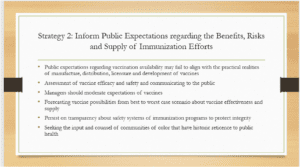
Despite the fact that the new technology can accelerate production of vaccines, public expectations regarding the vaccine availability may not be in alignment with the practical realities of the development, manufacture, licensure and distribution of the vaccines. By failing to deliver as promised, the U.S. government can frustrate the pandemic-weary people, lose their trust, and suffer institutional illegitimacy. Organizations and managers can therefore learn from the past experiences by moderating people’s expectations by preparing communities to continue implementing protecting and risk reduction measures (Schoch-Spana et al, 2021). They also need to maintain transparency and openness in every phase of vaccine testing, administration, licensure, and distribution and let the public know how this could influence the availability of the vaccines. For instance, a vaccine can prevent severe disease, but not infection, and the public should be informed of such possibilities and how they can impact health care provisions. Additionally, managers can borrow the use of independent oversight regarding vaccine safety to compare prior to the vaccine rollout and post rollout incidences like it was done in 2009 to 2010 HINI pandemic (Schoch-Spana et al, 2021). Lastly, promotion efforts need to engage people of color early and frequently to address inequalities in health care.
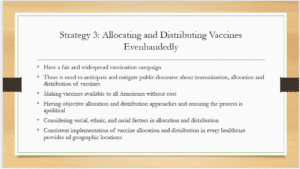
Perceives inequalities could affect public opinions about fairness on the distribution of vaccines after allocation is not necessary. In the U.S. Black populations experience increased mortality and morbidity compared to White counterparts in the manner that cannot be accounted for by income and health care access (Schoch-Spana et al, 2021). Therefore, Schoch-Spana et al (2021) suggest that public health authorities have to anticipate and mitigate discourse of the public about vaccine allocation and distribution as well as prejudicial ideas regarding social worth. They should explain that vaccination is for who public health regardless of legal and social status. Managers and organization can emulate by making the vaccines available to everyone and at no cost to remove barriers to immunizations. They can also come up with objective allocation and distribution approaches and give concrete evidence that the whole process is apolitical. Moreover, taking into account social, ethnic, and racial factors would help reduce the inequalities and fairness issues associated with the allocation and distribution of vaccines. Lastly, they should employ consistent guidelines of allocation and distribution all over the U.S. regardless of healthcare providers and geographic locations.
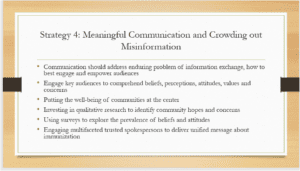
Past experience with communication show that it is important to engage the key audiences to comprehend their beliefs, perceptions, attitudes, values and concerns (Schoch-Spana et al, 2021). This can be used to develop messages that would resonate. This communication should focus on addressing the enduring challenge of how best to engage, empower audiences and exchange information with the people who have diverse life circumstances and beliefs. According to Schoch-Spana et al (2021), managers and organizations should see that they put the well-being of the communities in the immunization efforts. They should also invest in qualitative research which can provide insight on why and how participants behave, think and feel in certain ways. Moreover, a survey research can give a broad range of opinions from the public and this would inform communication campaign regarding immunizations. Lastly, engaging a broad network of spokespersons who can be trusted to reinforce and deliver unified immunization message would help mitigate ethical and legal challenges regarding COVID-19 immunizations.
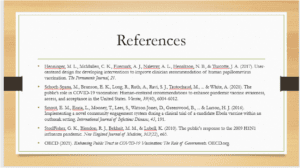
ORDER A PLAGIARISM-FREE PAPER HERE
We’ll write everything from scratch
Question 
Recommend 5 strategies managers and organizations could use to be more socially responsible in trying to correct the legal and ethical issues related to the topic and provide a brief description of each strategy.

Immunization Policies Pre VS Post Post-Covid
Select 1 of the strategies discussed and explain why it is the best strategy to use for the public health topic selected.
Include speaker notes,
Notes:
I am in the United States, so the policies and items need to pertain to the United States please